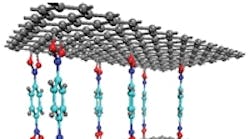Graphene, made of carbon formed into sheets just one atom in thickness, appears to be a promising base material for capturing hydrogen, according to new research at the National Institute of Standards and Technology (NIST) and the University of Pennsylvania. The findings suggest that stacks of graphene layers could potentially store hydrogen safely for use in fuel cells and other applications, including a range of sensors and semiconductor devices.
Graphene does not store hydrogen well in its original form, according to a team of scientists studying it at the NIST Center for Neutron Research. But if oxidized graphene sheets are stacked on top of one another — like decks in a multilevel parking garage, connected by molecules that link the layers to one another yet maintain space between them — the resulting graphene-oxide framework (GOF) can accumulate hydrogen in greater quantities. Inspired to create GOFs by the metal-organic frameworks that are also under scrutiny for hydrogen storage, the team is now beginning to uncover the new structures' properties. The GOFs can retain 1% of their weight in hydrogen at a temperature of 77 kelvin and ordinary atmospheric pressure, comparable to the 1.2% that some well known metal-organic frameworks can hold.
Some of the GOFs' capabilities are due to the linking molecules themselves. The molecules that the team used are all benzene-boronic acids, which interact strongly with hydrogen in their own right. But by keeping several angstroms of space between the graphene layers, they also increase the available surface area of each layer, giving it more spots for the hydrogen to latch on. According to the team, GOFs will likely perform even better once the team explores their parameters in more detail. The research is funded in part by the Department of Energy. For more information, visit www.nist.gov.

